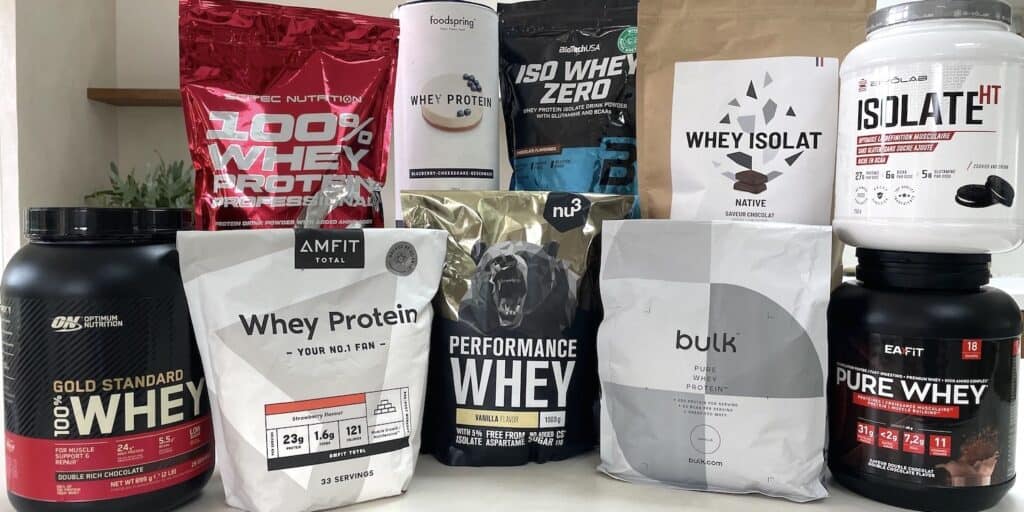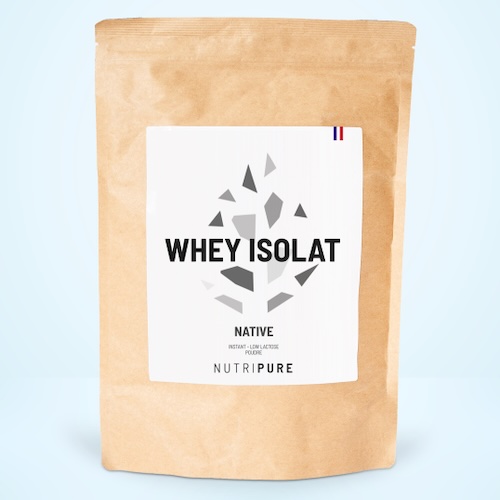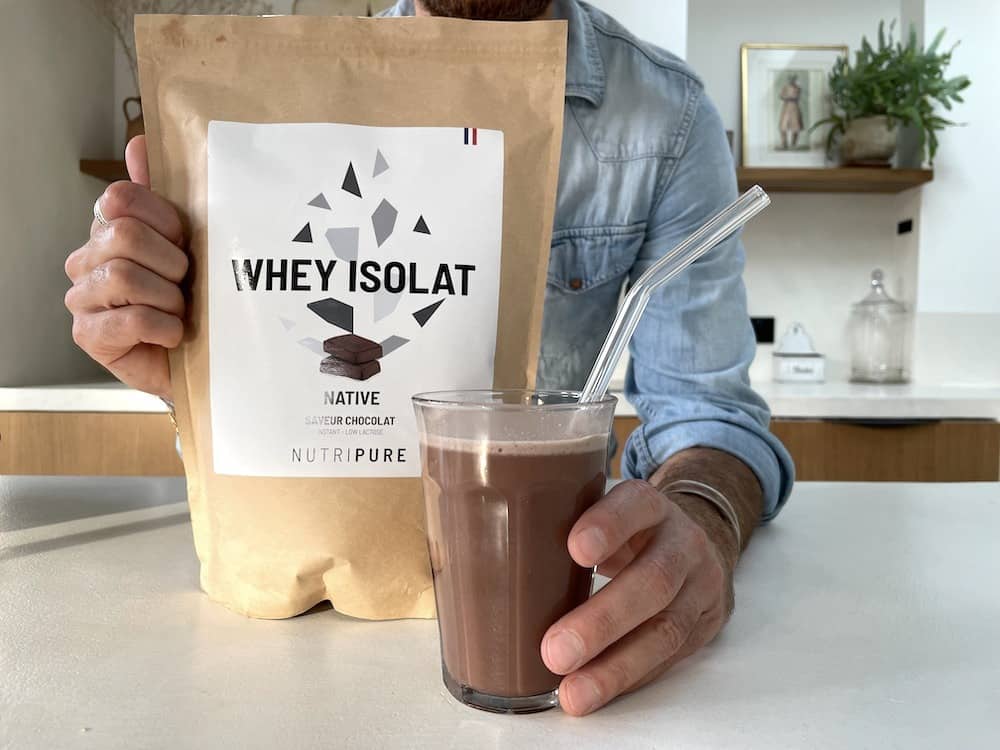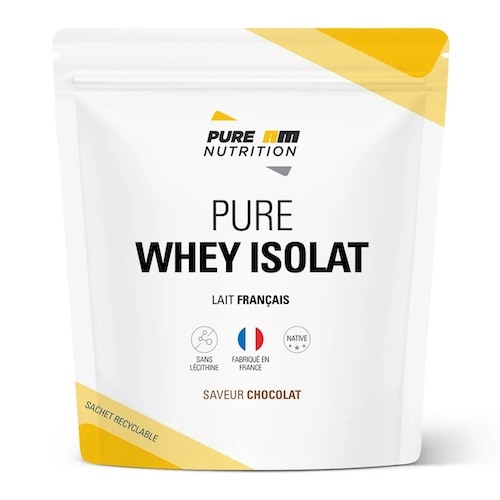MY SELECTION
#1 : Best unflavored whey 🥇
> Native Whey Isolate – Nutripure
#2 : Best flavored whey
> Native Whey Isolate – Nutri&Co
#3: Best value for money
> PURE Native Whey Isolate – AM Nutrition
Whey comes from the dairy industry, it is derived from milk serum, or whey. Milk serum is obtained during the coagulation of milk in the cheese-making process.
This milk serum mainly contains lactose and small soluble proteins rich in essential amino acids. Its biological value (the degree of assimilation and the quality of the amino acids) is 104 to 114, making it one of the best proteins.
It’s easy to see why athletes have become accustomed to consuming it to meet their protein needs and to increase their muscle mass.
But there are many types of whey, and even more brands: it is increasingly difficult to make sense of the labels and therefore to make the right choice.
To make things clearer, I tested and compared 15 of the best-selling whey proteins on the Internet, I rated them according to 5 quality criteria, then I selected the 3 best products.
Tested brands : AMFIT, BiotechUSA, Bulk, EAfit, Eiyolab, Foodspring, My Protein, NU3, Nutri&Co, Nutrimuscle, Nutripure, Optimum Nutrition, Protein Works, Pure AM Nutrition, Scitec Nutrition.
We evaluate all dietary supplements independently. If you click on one of the provided links, a commission may be paid to us, without affecting the price or the ranking.
My scoring criteria
To compile this comparison, I determined 5 qualitative criteria based on the products’ characteristics and on my testing of each of the 15 whey proteins.
Each criterion is scored out of 5, and the average of the 5 criteria determined my ranking.
For each whey, I also looked at the price per kg, to highlight the best options in terms of value for money
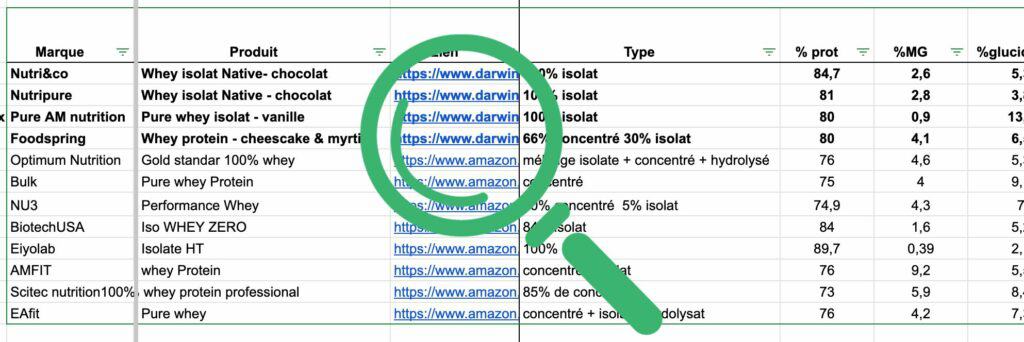
→ Access my full comparison table here (Google Sheet)
1. Nutritional value
To compare the nutritional value of the different whey proteins, I relied on two main criteria: their protein content and their richness in BCAAs.
To make the comparison as fair as possible, I checked the ingredients and nutritional values of the chocolate-flavored versions, which are generally the most consumed.
In general, the richer a whey is in protein, the less carbohydrates and fats it contains — which is a good indicator of quality.
Conversely, when the protein content is lower, one often finds more so-called ‘filler’ ingredients.
The BCAA content (branched-chain amino acids) is also an essential criterion. The more BCAAs a whey contains, the more effective it will be to support muscle building. It is also a reflection of the quality of the milk used and of a gentle extraction process, which helps preserve the integrity of the proteins without denaturing them.
2. Safety
To rate the safety of the different whey products, I relied on 4 sub-criteria:
- The origin of the milk used and how the cows are fed
Thus, pasture-raised or grass-fed cows produce milk of better quality than cows from intensive farming.
- Native quality or not
When whey is native, the filtration is done cold, which helps maintain the full integrity of the proteins.
- The number of additives and texturizing agents
Most of the texturizing agents used are not controversial, but their presence in large quantities is not ideal for the body. In daily life, it’s about consuming products with the shortest possible ingredient list.
- The sweeteners used
There are 3: sucralose, acesulfame K and steviol glycoside. The first two are controversial while steviol glycoside seems, for the moment, harmless.
3. Brand reputation
To evaluate the reputation of the different whey brands, I looked at several data points:
- The brand’s longevity
A brand that has been present for several years (or decades) has often proven itself. It has been able to retain its customers and maintain a certain level of quality. For me, it’s a genuine sign of reliability.
- Presence on Instagram
I also looked at the size of the communities on Instagram. It’s not the most decisive criterion, but it gives an idea of the engagement around the brand and of the relationship it has with its customers.
- Customer reviews
I relied on feedback available on platforms like Amazon, Trustpilot or Avis Vérifiés (depending on which one is most used for each brand). I did not take into account ratings for brands with fewer than 100 reviews, as that seems too unrepresentative. Conversely, a large number of positive reviews is a true sign of customer satisfaction and therefore a good indicator of trust.
4. Solubility
A whey that mixes well and doesn’t clump is pleasant to consume.
So I tested the solubility of the 15 brands by mixing 30 g of whey with 250 ml of water in a shaker. Each whey was mixed for 10 seconds to ensure a fair comparison.
5. Taste
This part is more subjective, so I relied on my personal tastes!
I evaluated:
- The texture, favoring creamy textures
- The intensity of the sweet taste, favoring less sweet whey.
- The naturalness of the flavor, favoring natural flavors and penalizing tastes that are too artificial
6. Price per kg
I have always compared the prices of “small” sizes, the pouches ranging from 750 g to 1 kg. Indeed, prices vary greatly depending on the quantity: the more you buy in large quantities, the lower the price per kg.
When a discount is applied permanently, it is included in the final price for comparison.
The price per kg is not included in the calculation of the final score, but it provides a clear view of the value for money offered by each brand.
Best whey proteins: my opinion
#1: BEST UNFLAVORED WHEY 🥇
Advantages 👍
- Highest protein and BCAA content
- Native, non-denatured protein
- French milk from pasture-fed cows
- The purest whey in the comparison
Disadvantages 👎
- Price slightly higher than average
Nutripure is a French brand created in 2018 by two high-level athlete brothers. Their ambition is to create a ‘perfect’ line of dietary supplements, meaning free from controversial substances and of optimal quality.
The Nutripure Native Whey Isolate contains 94 g of protein per 100 g with 22.4 g of BCAAs per 100 g, which is particularly high. It contains very little fat (1.9 g) and carbohydrates (3 g).
This whey is native, sourced from fresh milk from French pastures. The proteins are isolated by cold microfiltration. They therefore remain intact and are not denatured by heat treatment.
Nutripure avoids any controversial substances: this whey contains only milk isolate and sunflower lecithin, an emulsifier that is not problematic. The powder mixes very well, so it doesn’t clump.
There is also a cocoa version that brings an indulgent touch without an artificial aftertaste, although I would have preferred a slightly sweeter flavor.
This whey is one of the most expensive in our comparison (46.5 euros per kg), but the price is perfectly justified by the quality of the product.
BEST FLAVORED WHEY
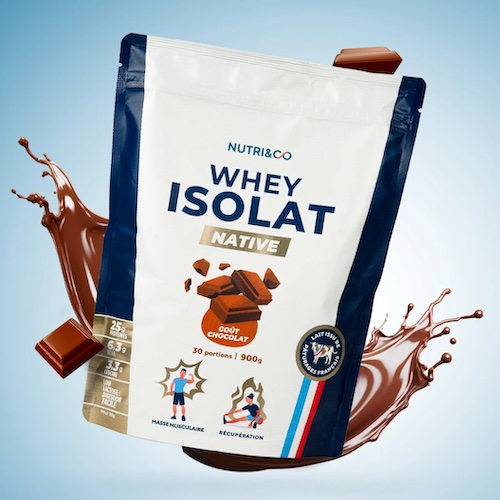
Nutri&Co: 5/5
Nutrition: ★★★★★
Safety: ★★★★★
Brand: ★★★★★
Solubility: ★★★★★
Taste: ★★★★★
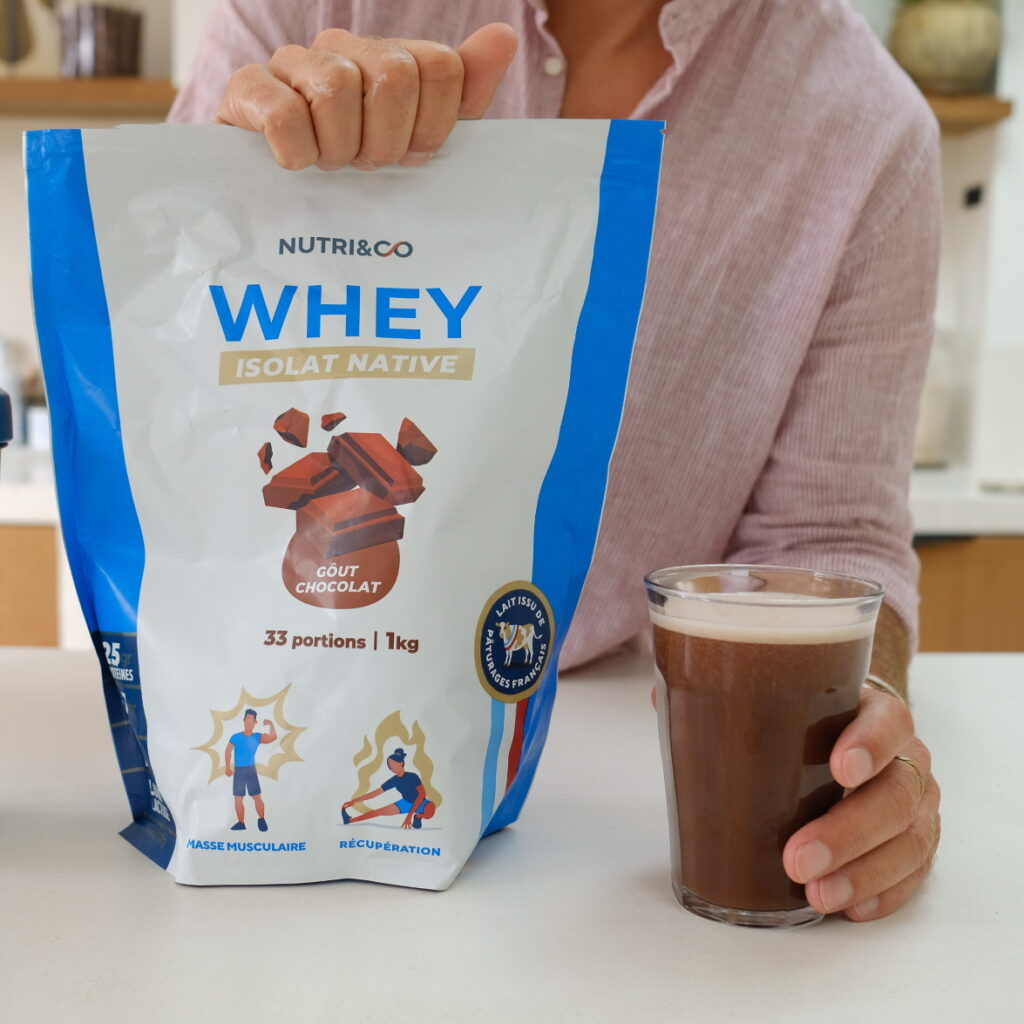
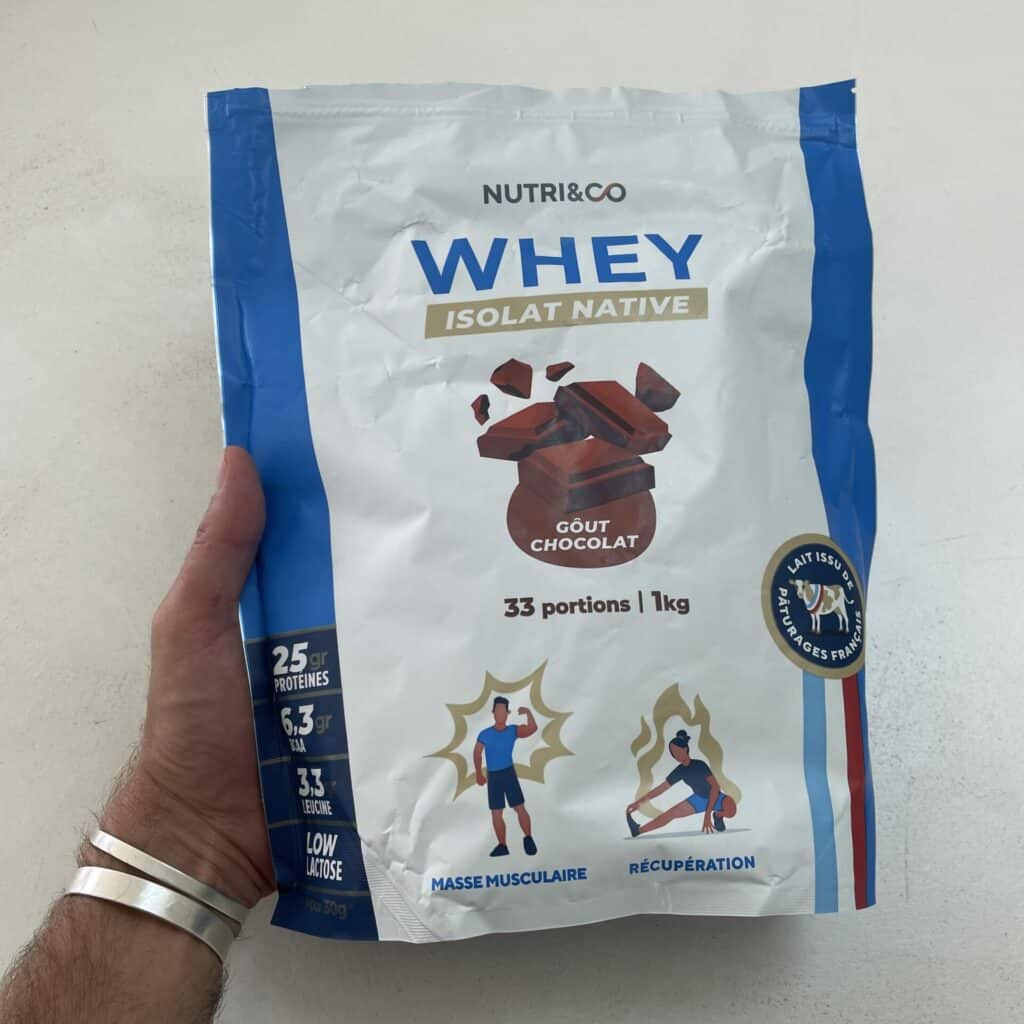
Advantages 👍
- High protein and BCAA content
- Native protein
- French milk from pasture-fed cows
- No sweeteners or controversial additives
- Good cocoa flavor, natural and balanced
Disadvantages 👎
- Price higher than average
Nutri&Co is a French brand created in 2017. It specializes in selling dietary supplements aimed at improving health, beauty and athletic performance. Its goal is to deliver the highest possible quality with simple formulas and no controversial ingredients, at a fair price.
Nutri&Co’s chocolate-flavored whey isolate and native whey contains 83 g of protein per 100 g with 24.8 g of BCAAs. This composition is very rare for a whey and reflects exceptional milk quality. It contains 5.3 g of carbohydrates, which is in the lower range of the comparison.
Nutri&Co whey is native, so it does not come from the whey of the cheese industry but directly from milk. The proteins are cold-extracted by microfiltration, which preserves their quality.
The milk used to make the whey comes from French pasture-raised cows, it’s the best possible quality for whey available today.
Nutri&Co whey contains only 2 additives: xanthan gum and sunflower lecithin. They are not controversial. The brand has chosen not to use chemical sweeteners: for sweetness, only the steviol glycoside (derived from stevia) is used.
The powder mixes well and doesn’t clump, its chocolate flavor is pleasant, with no chemical aftertaste.
The Nutri&Co brand also enjoys an excellent rating of 4.5/5 on Trustpilot, with many positive reviews highlighting product quality, brand transparency and responsive customer service.
This whey is one of the most expensive on the market at €49.90 per kg, but quality comes at a price!
BEST VALUE FOR MONEY
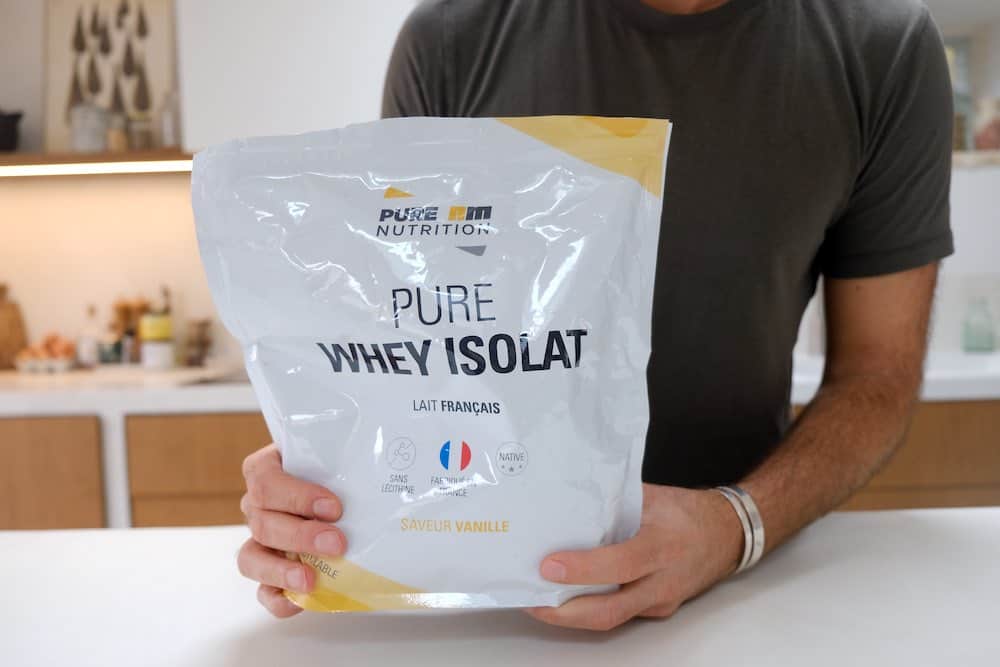
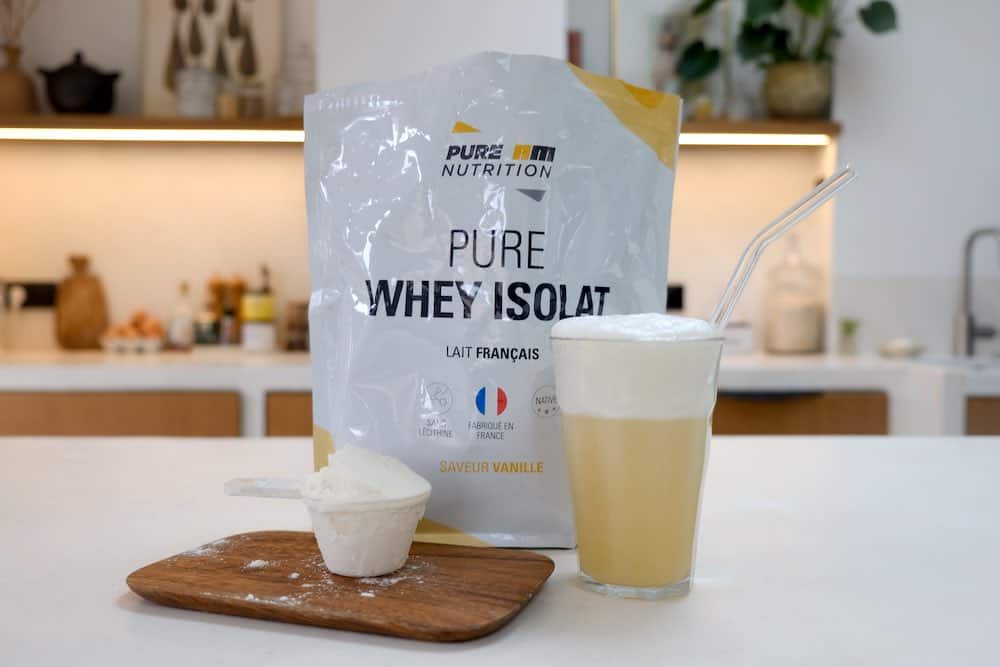
Advantages 👍
- High protein and BCAA content
- Native, non-denatured protein
- French milk
- Good balanced vanilla flavor
Disadvantages 👎
- Contains sucralose
- High lactose content
PURE AM Nutrition is a French brand founded in 2017, specializing in dietary supplements for athletes. It is part of the N4Brands group, which also owns FitnessBoutique, the leading retailer in France for the distribution of fitness equipment and sports nutrition products.
AM Nutrition’s whey isolate contains 85 g of protein per 100 g, with 17.5 g of BCAAs: it’s an excellent composition.
It contains very little fat (1.4 g per 100 g) but a rather high amount of carbohydrates (9 g). That’s uncommon for an isolate. This indicates a higher amount of lactose than some isolates. This can be problematic for sensitive or lactose-intolerant people.
AM Nutrition’s whey is native, it does not come from a by-product of the cheese industry but directly from milk: it is therefore of superior quality because no heat treatment is used to extract the proteins.
The milk used is French.
Its sweet taste is provided by a blend of sweeteners: steviol glycoside (natural) and sucralose (synthetic and sometimes considered controversial). I tried AM Nutrition’s vanilla-flavored whey: I liked its taste, sweet just right.
I was less fond of the rather thin and frothy surface texture with the presence of a few clumps. This texture most likely comes from the absence of a texturizing agent in the formula.
This native whey isolate is sold at a very reasonable price given its premium quality and formulation. Its price is €34.20 per kg with the use of a -20% promo code always available on the site: it’s unbeatable.
For me, this is the whey with the best value for money.
Other whey proteins in the comparison
Protein Works – Whey Protein 80
A concentrated whey at an attractive price, with a well-balanced chocolate taste and a creamy texture. It mixes easily and is very pleasant to drink. Its protein content is good for a concentrated whey.
Despite the presence of some additives, the lack of information about origin and the absence of details about the amino acid profile, it remains a convincing option for those on a tight budget.
Nutrimuscle – Native Whey Isolate
Nutrimuscle is a French brand known for its transparency and the quality of its products, notably its native whey isolate rich in protein (81.2 g/100 g) and BCAAs. Despite a relatively high carbohydrate content for an isolate (7.2 g), the presence of lactase allows for good digestive tolerance.
The formula stands out for the absence of glycomacropeptides, the presence of prebiotics and probiotics, and a smooth texture with a pleasant cocoa flavor. Offered at €42.90/kg, it delivers excellent value for money, despite the use of sucralose, a controversial sweetener.
Foodspring – Whey Protein
A blend of concentrated whey and isolate, offering a multitude of original flavors and an overall creamy texture, despite some possible clumping.
Sourced from milk of grass-fed pasture-raised cows in New Zealand, it stands out for the low protein content it provides — the lowest in our comparison. I also question the relevance of sourcing from so far away for a product whose quality could still be improved.
Optimum Nutrition – Gold Standard 100% Whey
A historic brand, this whey combines isolate, concentrate and hydrolysate for rapid absorption. I appreciated the chocolate flavor for its balance, with a smooth, lump-free texture. The protein content is adequate for a blend, but the BCAA levels could be higher.
This whey also contains controversial sweeteners. It’s also disappointing that there’s no information on the origin of the ingredients: a little more transparency would be welcome.
BiotechUSA – Iso Whey Zero
Very high in protein with added BCAAs and glutamine, this whey stands out for its native quality. The chocolate flavor is not very sweet, the texture is creamy, and solubility is impeccable. It is clearly positioned at the high end, with a corresponding price.
However, the presence of seven additives is excessive for a whey of this level, and the lack of information on origin remains regrettable.
Eiyolab – Isolate HT
Very protein-rich whey isolate (86%), with an exemplary BCAA amount of 20 g. Its texture is fairly liquid, very soluble, and free of clumps.
The milk used comes from Europe, which is a good point, but it’s still a bit vague: I regret not having more information on traceability. Also note for sensitive palates: the sweet taste is particularly pronounced.
My Protein – Impact Whey Protein
Ultra-popular concentrated whey, with a wide choice of flavors (36!). The chocolate flavor is very sweet but indulgent. The texture is fluid and solubility is good, making it an ideal option for regular use at a low price.
The protein content is average, but the amount of BCAAs remains noteworthy. However, there is a real lack of traceability, which is a shame.
Bulk – Pure Whey Protein
This concentrated whey has a decent but not optimal protein content, and a relatively low amount of BCAAs compared with other whey products on the market. I find it overall balanced, with a creamy texture, although it can sometimes form clumps. The vanilla flavor is classic and well balanced. It is made from milk of pasture-raised cows, which is appreciated, especially at this price.
We know it comes from Europe, but I would like more details for full traceability.
NU3 – Performance Whey
This whey has one of the lowest protein and BCAA contents in our comparison, which limits its nutritional value. It remains pleasant to consume, though: sweet, creamy, with very good solubility.
The vanilla flavor is intense, even too much for me. It contains 3 non-controversial additives, which is rather reassuring, although I regret the lack of traceability.
EAfit – Pure Whey
This whey is a blend of concentrate, isolate, and hydrolysate, enriched with vitamins and enzymes. It has an average protein content (76%) and a BCAA amount that is also lower compared with other products in the comparison. The double chocolate flavor is light and pleasant, the texture is smooth, and it dissolves very well.
I regret the presence of several controversial sweeteners, as well as an overall excessive number of additives, some of which are questionable. Another weak point: the total lack of information on the origin of the milk.
Scitec Nutrition – 100% Whey Protein Professional
This concentrated whey is enriched with enzymes, glutamine, and BCAAs, but despite that it contains little protein and a low amount of BCAAs compared to the other whey products in the comparison. It contains two controversial sweeteners, which gives it a very sweet and heavily flavored taste.
The texture is creamy, but I find the aftertaste a bit too persistent. As for solubility, nothing to complain about — it’s perfect. However, there is a real lack of transparency about the origin of the milk, and its price is clearly high given the quality offered.
AMFIT – Whey Protein
This simple and very economical whey is a blend of concentrate and isolate. The protein amount is not particularly high, and the absence of an amino acid profile prevents knowing the actual BCAA content, which is unfortunate. Its texture is a bit gritty, the strawberry flavor remains subtle, and a few clumps may appear.
It’s fine for getting started or as a quick fix, but I regret the lack of transparency about the milk’s origin and the formulation. This clearly shows in its low overall rating.
Full ranking
| Notes sur 5 | Note globale | Nutrition | Sécurité | Gout | Solubilité | Marque |
|---|---|---|---|---|---|---|
| # Best flavored whey 🍫 > Nutri&co – Native Whey Isolate | 5.0 | 5 | 5 | 5 | 5 | 5 |
| # Best unflavored whey 🥇 > Nutripure – Native Whey Isolate | 4.8 | 5 | 5 | 4 | 5 | 5 |
| # Best value for money 💸 > Pure AM nutrition – Pure Whey Isolate | 4.4 | 5 | 4 | 5 | 4 | 4 |
| Nutrimuscle | 4.4 | 5 | 4 | 4 | 5 | 4 |
| Protein Works | 4.4 | 4 | 3 | 5 | 5 | 5 |
| Foodspring | 4.2 | 4 | 4 | 5 | 4 | 4 |
| Optimum Nutrition | 4.2 | 4 | 3 | 5 | 5 | 4 |
| BiotechUSA | 4.0 | 4 | 3 | 5 | 5 | 3 |
| Eiyolab | 4.0 | 5 | 4 | 3 | 5 | 3 |
| My Protein | 4.0 | 4 | 4 | 4 | 5 | 3 |
| Bulk | 3.8 | 3 | 4 | 5 | 3 | 4 |
| NU3 | 3.8 | 3 | 3 | 4 | 5 | 4 |
| EAfit | 3.6 | 4 | 3 | 2 | 5 | 4 |
| Scitec Nutrition | 3.4 | 3 | 3 | 3 | 5 | 3 |
| AMFIT | 3.2 | 3 | 3 | 4 | 4 | 2 |
→ Access my full comparison spreadsheet here (Google Sheet)
Different types of whey
Whey concentrate
This is the best-selling whey on the market. Concentrated whey mainly comes from the cheese industry.
During cheese making, casein (a solid protein) is separated from the whey, or milk serum, by a high-temperature thermal treatment. This treatment denatures part of the proteins. The whey is then dehydrated, which produces concentrated whey.
It contains about 80% protein, but also fats and lactose. Its cost is relatively low, making it an attractive option for tight budgets. However, people who are sensitive to lactose should be careful because it is less digestible.
Native whey
Native whey does not come from the cheese industry. The whey is separated from the casein by cold filtration directly from the milk. There is no protein denaturation.
This whey is purer and therefore better absorbed and more digestible. It is considered a high-quality whey. However, its more demanding manufacturing process makes it more expensive.
Whey isolate
The whey isolate is a concentrated whey that has undergone an additional filtration. It is stripped of much of its fat and lactose.
It is especially interesting for people who are lactose intolerant, or for people who want to add as few calories as possible to their diet.
Its nutritional richness is exceptional because it contains about 90% protein, but its production is more expensive.
Good to know: a whey can be both native and isolate. It is the best quality on the market.
📚 Read also | Best whey isolate: a dietitian’s selection
Hydrolyzed whey
Hydrolyzed whey is an isolate whey that has undergone an additional enzymatic treatment. This process causes a kind of pre-digestion of proteins, which makes them more rapidly assimilable by the body.
It is the most processed form of whey, but also the most digestible. It is ideal for people with digestive disorders or for athletes who need an immediate protein intake: very intense training sessions or competitions.
It is generally more expensive and has a more bitter taste, because hydrolysis releases peptides with a stronger flavor. Even when flavored, hydrolyzed whey remains less pleasant to consume than other types. This factor should be taken into account before adopting it.
Vegan whey
There is no such thing as vegan whey: by definition, whey comes from milk and therefore contains animal proteins.
However, there are many 100% plant-based alternatives in the form of protein powders.
These substitutes, suitable for a vegan diet, are often composed of a blend of pea, rice, hemp, and soy proteins, to ensure a complete amino acid profile.
📚 Read also | Comparison of the best plant-based protein powders
Frequently Asked Questions (FAQ)
What is whey used for?
Whey is a fast and easily absorbed source of protein, used to meet increased protein needs, especially for those who train regularly or intensively.
It contains all essential amino acids, with a high content of BCAAs, making it an excellent support for recovery and muscle growth. Thanks to its composition, whey is digested quickly, allowing muscles to receive immediately what they need after exercise.
In summary, whey is not a meal replacement, but a convenient supplement to optimize protein intake, promote recovery, and support muscle building, especially after training.
How much whey should you consume per day?
The amount of whey to consume depends on your overall protein needs, which vary according to your weight, your level of physical activity, your goals (bulking, maintenance, weight loss), and what you eat.
If your diet already covers much of your needs, whey can simply serve as a supplement.
In general, I recommend about 20 to 30 g of whey after a workout to promote muscle recovery. This corresponds to a standard serving, easy to include during the day.
There is no need to consume it in excess: what matters is the balance of your total protein intake over the day, not the amount of whey itself.
How many times per day can you take whey?
Again, there is no universal rule. It all depends on your protein needs and what you are already consuming through your diet.
For example, a person who eats a lot of meat, fish, eggs, or dairy products will probably not need more than one serving (or possibly none). Conversely, someone following a diet low in animal products or who has very high needs (intense training, bulking) may take it twice a day.
What matters is not the number of servings, but the total amount of protein consumed throughout the day. Whey simply complements the diet; it does not replace it.
Where can I buy whey?
You can easily find whey online or in stores.
It can be found in shops specializing in sports nutrition, in some large sporting goods stores, and even in pharmacies. And of course online, either on platforms like Amazon, or directly on the brands’ websites, which can sometimes offer advice or exclusive promotions.
As part of our test, we ordered whey on Amazon or directly from the brands via their online stores.
The most important thing is to choose a brand that is transparent about its composition, with good traceability of the ingredients.
When should you take whey?
There is no single schedule that suits everyone, but certain times are more relevant depending on your goals.
The most common time would be right after a workout: muscles are more receptive to protein, and whey, which is absorbed quickly, helps optimize recovery and muscle rebuilding.
You can also take it as a snack, especially if meals are far apart or low in protein, or incorporate it into a meal (in porridge, a smoothie, etc.) to enrich the meal.
The main thing to remember is that spreading your protein intake throughout the day is more effective than concentrating it in a single meal or only after exercise. The body uses protein better when it is spread out regularly, meeting its needs at each time of day.
Whey or casein?
Whey, or lactoserum, comes from the liquid part of milk after coagulation. It contains soluble, small proteins that are very easy to digest and are rapidly absorbed. That’s what makes it an excellent choice right after training, to quickly supply the muscles with the amino acids they need.
Casein, on the other hand, comes from the solid part of milk, which is found in yogurts, fromage blanc, skyr, faisselle… These are larger proteins, slower to digest, and sometimes less well tolerated depending on the person.
Usage is therefore different: casein is often taken in the evening to slowly release protein overnight, which helps limit muscle catabolism (muscle breakdown).
That said, casein is mainly intended for those who have very high protein needs, such as people engaged in very intense sports like bodybuilding. For the majority of people who train, whey is more than sufficient.
Whey or BCAA?
BCAAs (valine, leucine, isoleucine) are three essential amino acids: the body cannot produce them; they must come from the diet. They play a key role in muscle building and recovery. Without them, there is no effective protein synthesis.
That said, if you consume a high-quality whey, you already get a good dose of BCAAs. It is therefore not necessary to add more, except in very specific cases.
Taking BCAAs can be useful just before training, particularly to limit muscle catabolism during long or intense sessions. But if your overall protein intake is sufficient, it’s not essential.
In summary:
- BCAAs are already present in good amounts in a good whey
- Taking extra BCAAs is only worthwhile in certain specific contexts
- The priority remains to have appropriate protein intake throughout the day
📚 Read also | Comparison of the best BCAAs
Whey or creatine?
It’s a question I’m often asked, and actually… they are two very different things.
Creatine is an amino acid derivative naturally present in the body, especially in the muscles and the brain. It is produced by the kidneys, the liver and the pancreas from three amino acids: arginine, glycine and methionine. Its role is to provide energy quickly during short, intense efforts. It is therefore particularly useful for strength, power, or bodybuilding sports.
Whey, on the other hand, is a source of protein. It serves to promote muscle recovery and the development of lean mass after exercise. So, nothing to do with creatine.
In summary:
- Creatine boosts performance during workouts.
- Whey helps with recovery and muscle building.
Both can complement each other, depending on your goals.
📚 Read also | Which is the best creatine on the market?
Does whey make you lose weight?
No, whey is not a weight-loss product. Its primary role is to support the growth or maintenance of muscle mass, especially in active people.
On the other hand, building muscle mass increases the basal metabolic rate, that is, the amount of energy the body expends at rest. In this context, if the diet is hypocaloric (caloric intake below needs), whey can indirectly help promote fat loss by limiting muscle wasting and aiding recovery.
Are there any dangers or contraindications to consuming whey?
Whey itself is not dangerous. If used to supplement protein intake in a balanced diet, it can even be very useful: for athletes, vegetarians, or simply those who have difficulty meeting their daily protein needs.
But as with anything, excess is what causes problems. When too much protein is consumed over the long term, especially as part of a diet already too high in calories, there can be adverse effects: digestive issues, strain on the kidneys or liver, or even unwanted weight gain.
In some young people, a possible worsening of acne is also observed, particularly with regular whey consumption in the context of an unbalanced diet.
People who have renal insufficiency, even mild, should be very careful. In that case, consuming whey without medical advice is strongly discouraged.
Is whey essential for building muscle?
No, definitely not. I’m often asked the question, and I repeat: you can absolutely gain muscle without ever touching a shaker. What matters is getting enough protein throughout the day, and that can work perfectly well with a regular diet: meat, fish, eggs, legumes, tofu, dairy products…
Whey is just a tool. It can be helpful when you have a busy schedule, a small appetite, or somewhat higher needs. But it’s neither essential nor magical. If your plate is well balanced, you can easily do without it.
Bibliography
1. Castro LH, de Araújo FH, Olimpio MYM, de B Primo R, Pereira T, Lopes LA, de M Trindade BS, Fernandes R, Oesterreich SA. Comparative meta-analysis of the effect of supplementation with concentrated, hydrolyzed, and isolated whey proteins on athletes’ body composition. Nutrients. September 2, 2019; 11(9): 2047. https://pubmed.ncbi.nlm.nih.gov/31480653
2. Smith GI, Commean PK, Reeds DN, Klein S, Mittendorfer B. Effect of protein supplementation on muscle mass and strength during diet-induced weight loss: a randomized controlled trial. Obesity (Silver Spring). May 2018; 26(5): 854-861. https://pubmed.ncbi.nlm.nih.gov/29687650
3. Vandenplas Y. Lactose intolerance. Asia Pac J Clin Nutr. 2015;24 Suppl 1:S9-13. https://pubmed.ncbi.nlm.nih.gov/26715083
4. Vasconcelos QDJS, Bachur TPR, Aragão GF. Whey protein supplementation and its potentially harmful effects on health: a systematic review. Appl. Physiol. Nutr. Metab. 2021; 46(1):27-33. https://pubmed.ncbi.nlm.nih.gov/32702243
5. Ju Q, Tao T, Hu T, Karadağ AS, Al-Khuzaei S, Chen W. Sex hormones and acne. Clin Dermatol. March-April 2017; 35(2):130-137. https://pubmed.ncbi.nlm.nih.gov/28274349
6. Volek JS, Volk BM, Gómez AL, et al. Whey protein supplementation during resistance training increases lean mass. Journal of the American College of Nutrition. 2013;32(2):122-135. doi:10.1080/07315724.2013.793580. https://www.tandfonline.com/doi/full/10.1080/07315724.2013.793580
7. Li M, Liu F. Effect of whey protein supplementation during resistance training sessions on body mass and muscle strength: a meta-analysis. Food Funct. 2019;10(5):2766-2773. https://pubmed.ncbi.nlm.nih.gov/31041966
8. DeDevries MC, Phillips SM. Protein supplements for muscle mass and health: Advantage whey. J Food Sci. 2015;80 Suppl. 1: A8-A15. https://pubmed.ncbi.nlm.nih.gov/25757896
9. Naclerio, F. and Seijo, M. (2019). Whey protein supplementation and muscle mass: current perspectives. Nutrition and Dietary Supplements, 11, 37–48. https://doi.org/10.2147/NDS.S166195
10. Sharp, M., Shields, K., Lowery, R., Lane, J., Partl, J., Holmer, C., … Wilson, J. (2015). Effects of beef protein isolate supplementation and whey protein isolate supplementation on lean mass and strength in resistance-trained individuals: a double-blind, placebo-controlled study. Journal of the International Society of Sports Nutrition, 12 (sup1) https://doi.org/10.1186/1550-2783-12-S1-P11


